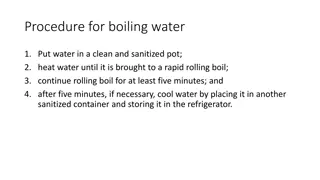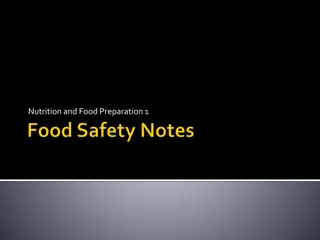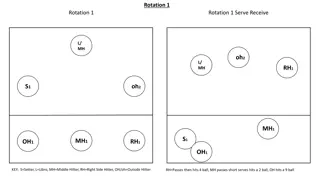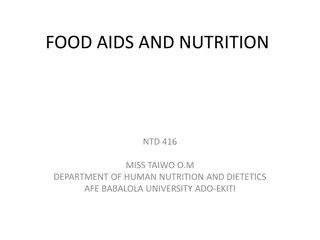Smart Tips for Effective Food Storage and Rotation
When it comes to food storage, starting with foods your family already eats is key. Learn how to create 30 days of menus to plan your 3-month food supply effectively. Find out how to rotate your food storage to keep it fresh and edible, ensuring you are prepared for emergencies.
Download Presentation

Please find below an Image/Link to download the presentation.
The content on the website is provided AS IS for your information and personal use only. It may not be sold, licensed, or shared on other websites without obtaining consent from the author. Download presentation by click this link. If you encounter any issues during the download, it is possible that the publisher has removed the file from their server.
E N D
Presentation Transcript
Jennifer Reynolds Tempe South Stake Canning Specialist
http://preparedldsfamily.blogspot.com/2009/05/3-month-food-storage-supply-how-to.htmlhttp://preparedldsfamily.blogspot.com/2009/05/3-month-food-storage-supply-how-to.html This may seem obvious, but it is the one of the main reasons that food storage does not get used. Start by storing foods that your family already eats. Then when you want to add a new food to your storage, learn how to use it so it won t just sit on your shelf gathering dust. We eat the same main dishes about 80% of the time because of taste, habit, awareness, familiarity, etc. Using your food storage can be as simple as creating a list of dishes eaten and liked by your family. The created list should be at least 10-20 dishes long. Look in your pantry and see what you already are using on a regular basis. To get started, create 30 days of menus to help your family plan your 3-Month Food Storage supply. This will help you figure out what your family will eat, and what you need to put in your food storage.
http://preparedldsfamily.blogspot.com/2009/05/3-month-food-storage-supply-how-to.htmlhttp://preparedldsfamily.blogspot.com/2009/05/3-month-food-storage-supply-how-to.html How to create 30 days of Menus: 1. Write down breakfast, lunch, dinner and snack menu's that your family will eat. Don't make 5- course meals. Simple meals are best! You can repeat meals over and over again. Make a list of things you see in your pantry already to help with menu planning (see pantry list next slide). 2. You will need to convert recipes with perishable foods with other foods. Use dry, canned, and packaged foods in most meals. Most food storage recipe books use a combination of shelf foods and perishable foods. 3. List all of the ingredients of your menus. If you can't use a spreadsheet, just write ingredients or items down and add them up on paper (see menu planning in subsequent slides). 4. Create 25% of your menu's with prepared foods like stews, soups, pasta meals, pancake mix or items like Bisquick. This will help in short term disasters or emergencies. 5. Use some long-term foods (wheat, rice, dry beans, etc.) in your menu planning as well. 6. Don't think of these menu's as an "end of the world" project, but an everyday one that you can easily resupply and stock up on. 7. After you come up with the 30 menus, then multiply all ingredients by 3 to become your 3- month food storage supply.
Rotating food storage is the best way to ensure that the food you have stored will be edible and as fresh as possible when you need to use it. Rotation allows your family to get accustomed to eating stored and dehydrated food which is essential in emergency situations. Tips for rotating your food storage: Keep small amount of your food storage in your kitchen. Stock your kitchen shelves with small containers filled with egg mix, powdered milk, dried beans, wheat, rice, etc. This will serve as a subtle reminder that you have these items without taking up your whole kitchen. Stock your shelves with your ready-made items as well. The more you see these items the more often you will use them. (We made a pantry shelf- next slide). The best way to rotate your food storage is to use it to make food on a regular basis for yourself and your family. Incorporate food storage items into you favorite recipes. This will form a great habit for rotating and will help you easily substitute your food storage items in every day recipes. Make a one-week menu consisting only of items in your food storage and then live on it. This exercise will really put your food storage to the test. After completing this exercise you will have a better idea of what might be lacking to make your year supply complete. Learn new cooking methods to expand what you can store in your food storage supply (i.e. Pressure Canning, Wet-Pack Canning, Food Dehydrating, etc.) http://www.reynoldsnet.org/preparedness/Cooking_Methods.html http://www.reynoldsnet.org/preparedness/Cooking_Methods.html
Our family created this pantry shelf due to our small pantry and as a reminder for us to rotate our food storage. These shelves are installed on the back of your existing pantry door and they have the advantage of adding more space in your pantry, displaying all of your food storage items in "clear" easily accessible containers. Not only does this help reduce the need for having clumsy #10 cans in your pantry but now these items are within reach so you don't forget to use your food storage.
After you created your 30-day menu of meals your family likes, think about ways you can incorporate your ready-made items and long-term food storage items into each recipe. Which of the dishes could include the addition of basic food storage items? For Example: Meat Loaf Chili Tuna Noodle Casserole Stroganoff Hamburger Macaroni Stuffed Green Peppers Chicken Tonight Chicken Enchiladas Shepherd s Pie Chicken Noodle Soup Chicken Divan Ham Fried Rice Choc. Chip Cookies Pancakes Vegetable Soup For Example: Add rice and/or wheat berries and/or dry beans. Add wheat and/or rice Add wheat. Serve over rice. Add wheat berries to sauce. Add dry beans. Add rice and/or wheat. Add cooked dry beans. Use dry milk base. Add cooked dry beans. Add rice and wheat. Add wheat. Serve over rice. Add wheat. Add oatmeal and wheat flour. Make mix using dry milk, wheat flour, and oatmeal. Add beans, rice and wheat berries
The Mesa Home Storage Center carries 22- prepackaged items in #10 cans, mini- pouches and in bulk which are a great resource for your long-term storage supplies. You can also purchase many of these items from the LDS Distribution Center and have them delivered to your home: http://store.lds.org/webapp/wcs/stores/servlet/Category3_715839595 _10557_3074457345616706237_-1_N_image_0 I will be giving tips for using some of these basic food storage items today.
Why store wheat? Whole-wheat flour contains more minerals and vitamins then white flour. Whole wheat contains B vitamins, which are necessary for healthy nerves. Whole-wheat foods provide more fiber than do food made from white flour. Whole wheat helps you loose weight! The bounteous fiber keeps you fuller longer, cuts absorption of calories, cleans out impurities, requires more chewing, takes half as much to fill you up and takes longer to digest.
http://www.ldspreparedness.com/Files/cookbook.pdf Use wheat in recipes your family already likes, then it is not totally unfamiliar and you know the recipe is good. The term wheat grain, wheat berry or wheat kernel all refer to the same thing- the entire wheat grain that you get when you buy wheat. Try wheat in dessert recipes first- who does not like a cookie? If a recipe calls for white flour, you can usually substitute it for whole wheat flour. If you re nervous about the recipe turning out tasting too wheaty than you can use half white flour, half whole wheat flour. more like white flour, than hard red wheat. It s best to use wheat flour when you can disguise it in recipes using brown sugar, molasses, chocolate, or recipes that use fruit or vegetables, such as bananas, applesauce, carrots, or zucchini in breads, cakes and cookies. Use whole-wheat flour in recipes that call for oats or oat flour. Oats have a hearty flavor that helps disguise the flavor of whole wheat. If you are allergic to wheat use almond or rice flour as a substitute Honeyville you can use half white flour, half whole wheat flour. Hard white wheat tastes If you are allergic to wheat use almond or rice flour as a substitute- - Honeyville, Bobs Red Mill, and Amazon good source for purchase! , Bobs Red Mill, and Amazon good source for purchase!
Have a great breakfast in the morning by cooking wheat berries in a thermos or slow cooker overnight. Add dried fruit, spices and sweetener as you would with oatmeal. (1 c. wheat, 2 c. boiling water, tsp. salt). Out of pasta? Substitute wheat berries for pasta in your favorite pasta salad. The salad will be far more nutritious, and you ll save money. Add wheat berries to your favorite soup for extra nutrition or substitute for rice or barley.
In most recipes, cracked wheat can be used instead of rice or nuts. Cracked wheat can also be used as a meat extender or substitute. Crack wheat in small amounts (1/4 c. at a time) in your blender using the pulse option. Cook cracked wheat by bringing 1 c. wheat and 2 c. water to a boil and cook 10 To use as a substitute for meat, just add c. cooked cracked wheat for every pound of ground meat. Great list of other ideas for using wheat wheat, wheat grass, wheat sprouts, etc. today wheat In most recipes, cracked wheat can be used instead of rice or nuts. Cracked wheat can also be used as a meat extender or substitute. Crack wheat in small amounts (1/4 c. at a time) in your blender using the pulse option. Cook cracked wheat by bringing 1 c. wheat and 2 c. water to a boil and cook 10- -20 min. To use as a substitute for meat, just add c. cooked cracked wheat for every pound of ground meat. Great list of other ideas for using wheat- - Popped wheat, wheat grass, wheat sprouts, etc. (Handout provided today- - http://foodstoragemadeeasy.net/2009/10/23/7 wheat- -grinder/ 20 min. Popped (Handout provided use- - wheat http://foodstoragemadeeasy.net/2009/10/23/7- -great grinder/ ) ) great- -ways ways- -to to- -use wheat- -without without- -a a- -
Why store dried beans? Dried beans are cholesterol free, low in fat (only 2-3%), and high in fiber, protein, carbohydrates and contain many trace minerals. Beans can help lower your cholesterol because they are high in fiber and low in fat! Each c. serving of dried beans provides 6-7 grams of protein.
Dried beans should be soaked before cooking to restore moisture, reduce cooking time and to cut down on the gas they produce. Quick soaking: for 2 c. dried beans and 10 c. water and heat to boiling and let boil 2-3 min. Remove from heat, cover and set aside for an hour (beans should be triple in size). Discard soaking liquid and rinse beans and cook as normal. Our family pressure cans our beans in just 30 min without presoaking! For 2 c. of beans, add 6 c. water and bring up to high pressure and cook for 30 min. This method works best for older beans as well. Beans are great as a side dish, used in chili s, as a protein or thickener in stews and can be used as a substitute for butter, margarine or oil. To substitute beans for oil, margarine or butter in baked goods, match the bean with the color of the treat your making, so the color doesn t change. For example, black beans work great in chocolate-based baked goods and white beans work great in yellow cake. Just mash the beans and add to your favorite recipe!
Non-instant dry milk requires more mixing to hydrate- use a wire whisk or powdered drink mixer for more agitation for rehydrating. Use powdered milk in any recipe calling for milk by adding the dry powdered milk to dry ingredients and the necessary water to the wet ingredients. Powdered milk is great in any baking recipe, in smoothies, dressings and pudding as well. The best part of using powdered milk is you can use it to make buttermilk, sweetened condensed milk and evaporated milk which we don t typically have on hand. For drinking, mix half powdered milk with regular milk to get the family used to it and then increase amounts once they are used to it. Also add vanilla or other flavoring for improved taste. If you have older powdered milk, do not throw it away, you can still use it in cooking without a noticeable difference in taste. It can also be used as a fertilizer in your garden!
www.eatingwell.com/recipes_menus/collections/healthy_oats_recipeswww.eatingwell.com/recipes_menus/collections/healthy_oats_recipes Why store Oats? Oats are a great source of fiber, thiamine and iron. Oats are great as a cereal for breakfast! Oats can also be used in breads, granola, cookies, as a pie topping and so much more! Quick or rolled oats cook faster then whole (old fashioned) oats. Oat flour is a great substitution for those with gluten allergies. Add freeze-dried fruits to your oats recipes esp. granola for a delicious treat. Whole: Rolled:
Generally the darker the rice the more nutrients it contains. Rice is great as a side dish. It can be used in soups, in drinks and as a dessert. It can also be used like wheat as a meat extender. I saut long-grain rice in a couple of Tbs. of oil until translucent before adding liquid. This speeds up cooking time from 20 min to 15 min. General rule of thumb is 1 part rice to 2 parts water. Cook rice in beef or chicken broth instead of water for a delicious change. Mixed cooked rice with a variety of things liked sliced mushrooms, saut ed onions, bacon, silvered almond or grated cheese. Add herbs to the cooking water when preparing rice. Rice flour is also a good substitute for those with gluten allergies. Just blend rice in wheat grinder to make flour
I added dried fruits and veggies to our basic year supply to provide variety and more options especially for breakfast and snacks. Using potato flakes instead of making mashed potatoes will save you time in cooking and cleaning. They are great to use in bread recipes for a lighter, fluffier loaf. Dried onions, celery and carrots are a great staple to have on hand for making soups and stews and can speed up the cooking process since they rehydrate quickly. Dried fruits are a healthy alternative to potato chips and are a great snack for road trips. They can be used in any recipe and are a great way to spruce up your family recipes. Apple slices can be rehydrated and then put in a blender to make your own applesauce. This is a great substitute for oil in recipes as well.
There are many recipe books available using your long-term food storage items and here are some of them. My personal favorites are posted online on my website along with tips for using basic food storage items: http://www.reynoldsnet.org/preparedness/Recipes.html Mesa Home Storage, Basic Food Storage Cookbook (no longer available but scanned on my website) Crystal Godfrey, I can t believe it s Food Storage Vicky Tate, Cookin with Home Storage Food Storage Made Easy-70 food storage recipes that ONLY use the items included in the church s one month basic supply kit. That means the only ingredients needed to make all of these 70 items are wheat, flour, fat (oil or shortening), sugar, powdered milk, macaroni, quick oats, pinto beans, and salt. (http://foodstoragemadeeasy.net/fsme/docs/SHELF-STABLE- RECIPE-BOOK.pdf) Emergency Essentials- http://beprepared.com/education/food-storage-recipes.html New Ideas for Cooking with Basic Food Storage : http://www.ldspreparedness.com/Files/cookbook.pdf Utah Home Storage Center, Food Storage Recipes : http://www.mormonshare.com/wp- content/uploads/2014/08/BasicFoodStorageRecipes2.pdf University of Utah, Cooking with Food Storage Ingredients : https://extension.usu.edu/cache/files/uploads/Cooking%20with%20Food%20Storage%20Ingre dients%206-07.pdf
Visit my preparedness webpage for more tips: http://www.reynoldsnet.org/preparedness/

















































